You must be logged in to rate content!
25 minute read
Peugeot 404 Production History
Compliments of Tippett @ https://www.peugeot404na.com
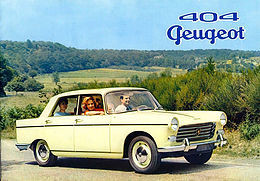
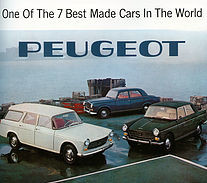
1960
The Peugeot 404 was developed at Peugeot and Pininfarina in the 1958-59 period, and introduced to the press in May 1960 (Watch Original Promo Here). The production run of the 403 and 404 coincided for 6 years, which was slightly more than half of the time the 403 was in production.
Roughly the same size as the 403, the 404 was an altogether more modern design, and was considered to be quite stylish at its introduction. The tailfins were a more refined version of the excesses seen in the late fifties and early sixties in US design. The sedan shared its general “look” with a few other Pininfarina-designed cars, notably the Austin Cambridge/Morris Oxford (a much heavier looking design) and the FIAT and SEAT 1800/2100 (double headlights, but similar). Some criticised Pininfarina for “selling the same design” to several manufacturers but there were many differences in detail and the 404 was probably the most elegant of the bunch.
Technically, the 404 had one foot in the past and one in the future. The engine and drivetrain were direct descendants from the 403 and the 203 before it. A three main bearing inline four cylinder engine called the XC, oversquare at 84 x 73 mm bore/stroke – giving 1618 cc – and a single choke carburetor with a manifold cast into the head itself, drove through a development of the 403’s gearbox (the C3) a propeller shaft encased in a strong torque tube, which connected to a bronze crown wheel in the rear axle through a steel worm. The crankshaft was in forged steel. The only concession to modernity in the engine was its 45 degree angle, for the 404 – in direct contrast to the 403 – had a lower hood line than front fender line. On the other hand, the front suspension used McPherson struts, a design from a Ford engineer of the same name, instead of a transverse leaf spring with lever arm shock absorbers as the 403 and its ancestors had. These struts were served by a well-isolated two piece wishbone lower arm system that provided excellent shock isolation due to the “Articone” bushings that connected the two piece arm together.
The braking system was originally modest, 255 mm (10 inch) front and rear drums with no assistance and single-acting “Twinplex” brake cylinders. Performance was adequate, with a top speed of 142 km/h (88 MPH) on the basis of the 72 HP engine.
Despite the conservative specification (would you expect anything else from Peugeot in the 1960s?), the whole was more than the sum of its parts and the 404 received wide praise in the press for its combination of good looks, unparalleled isolation from road noise, tight handling and responsive engine. The fuel consumption was modest, too.
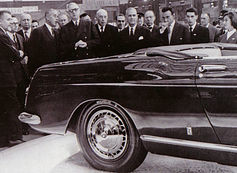
Charles de Gaulle at Paris Salon 404 cabriolet launch
First Cabs Arriving in USA
1961
Two developments in the 404 line occurred: at the Paris Salon, the elegant 404C Cabriolet was introduced, and a Kugelfischer (indirect) fuel injected engine called the XCKF was also announced. The Cabriolet was – to borrow an American phrase – a “personal car” in the general mold of the Ford Thunderbird, an upmarket version of a more basic sedan that would appeal to those looking for higher style, more sporting pretensions and the cachet of a semi-coachbuilt car. The production process for the 404C was complicated: the basic platform was assembled at Peugeot’s home factory of Sochaux, sent by train to Grugliasco Italy (near Torino) where Pininfarina is based, and the 404C bodies were built up there onto the Peugeot-supplied platforms. The interior was unique to the Cabriolet models as well and was entirely built in Italy. The bodies with interiors were then put back onto a train to Sochaux, where the mechanical units were added to the car. An interesting detail of this process is that each bodyshell was sequentially numbered in Italy (the “Carrosserie Peugeot” number), and because the cars were painted there, the Carrosserie Peugeot number was often mildly out of synch with the serial number, which was only affixed to the car when a production order for that particular colour came in.
Assembly at Pininfarina Plant
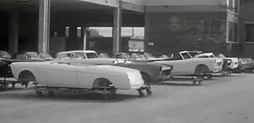
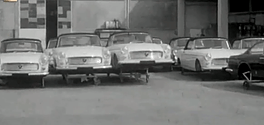
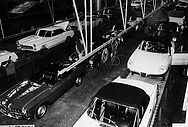
The lines of the 404C were much more rakish than those of the rather square-rigged sedan, and some intuitive attention was paid to aerodynamics, with a significantly more streamlined windshield and a sort of air deflector/spoiler mounted under the front bumper. This is not to say that it was a sports car: the gearshift was still mounted on the steering column and there was no tachometer.
Pininfarina proposed an (unofficial) hard top in 1961 at the Salon d’Auto, much to Peugeot’s chagrin because they hadn’t authorized it, but come 1962, this became an official factory option. The top speed of the carbureted 404C was 148 km/h (92 MPH) with the top up, and the extra 6 km/h over the sedan was a clear demonstration of the C model’s superior aerodynamics; mechanically, the two versions were identical.
The KF fuel injected engine was developed with the Cabriolet in mind, but it was also to become available for the sedan. It was generally similar to the carbureted engine in most respects, but there was an electric fuel lift pump mounted on the front crossmember, an elaborate fuel filter/water separator, one external intake runner per cylinder to allow for much improvement in engine breathing, and the 4 fuel injectors were positioned just upstream of the intake valves. The Kugelfischer system is quite simple, having a tiny piston for each engine cylinder, with the bottom dead centre for all pistons being variable and determining the amount of fuel to be injected. The bottom dead centre position was determined by engine coolant temperature, engine RPM and throttle position. A knob on the dashboard was used to richen the mixture for cold starts. The fuel consumption of the 85 HP KF Injection engine was lower than that of the carbureted engine, despite the higher power output.
With the introduction of the Cabriolet, the diameter of the front brake drums was increased to 280 mm (just over 11 inches). This modification carried over to the sedans too.
Despite not having a conventional automatic gearbox option, a Jaeger electromechanical automatic clutched version of the 404 sedan (Coupleur Jaeger) was optionally available. In this version, there was no clutch pedal, but the gearlever still protruded from the steering column; using the gearlever activated the electromagnetic clutch, which took care of half of the gear changing operation.
The first imports of the 404 to North America began in 1961.
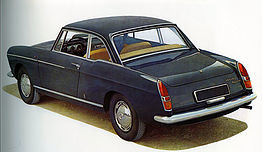
1962
The production of the 404 Cabriolet took off in 1962, despite the car carrying a more than 75% price premium over the equivalent sedan. Meanwhile, Peugeot commissioned a Coupé version of the 404C, which was in effect a fixed roof version of the Cabriolet, and like the Cabriolet, its body and interior were also built at Pininfarina. However, the Coupé roof is totally different from the hard top and many Club members and others consider this version to be the most elegant of all 404s. Structurally, the Coupé had all of the body reinforcements of the Cabriolet, plus a welded on roof, so the structure was immensely stiff compared to any other version of the 404. The Coupé was first shown at the October 1962 Paris Salon.
The lines of the 404C were much more rakish than those of the rather square-rigged sedan, and some intuitive attention was paid to aerodynamics, with a significantly more streamlined windshield and a sort of air deflector/spoiler mounted under the front bumper. This is not to say that it was a sports car: the gearshift was still mounted on the steering column and there was no tachometer.
Pininfarina proposed an (unofficial) hard top in 1961 at the Salon d’Auto, much to Peugeot’s chagrin because they hadn’t authorized it, but come 1962, this became an official factory option. The top speed of the carbureted 404C was 148 km/h (92 MPH) with the top up, and the extra 6 km/h over the sedan was a clear demonstration of the C model’s superior aerodynamics; mechanically, the two versions were identical.
The KF fuel injected engine was developed with the Cabriolet in mind, but it was also to become available for the sedan. It was generally similar to the carbureted engine in most respects, but there was an electric fuel lift pump mounted on the front crossmember, an elaborate fuel filter/water separator, one external intake runner per cylinder to allow for much improvement in engine breathing, and the 4 fuel injectors were positioned just upstream of the intake valves. The Kugelfischer system is quite simple, having a tiny piston for each engine cylinder, with the bottom dead centre for all pistons being variable and determining the amount of fuel to be injected. The bottom dead centre position was determined by engine coolant temperature, engine RPM and throttle position. A knob on the dashboard was used to richen the mixture for cold starts. The fuel consumption of the 85 HP KF Injection engine was lower than that of the carbureted engine, despite the higher power output.
With the introduction of the Cabriolet, the diameter of the front brake drums was increased to 280 mm (just over 11 inches). This modification carried over to the sedans too.
Despite not having a conventional automatic gearbox option, a Jaeger electromechanical automatic clutched version of the 404 sedan (Coupleur Jaeger) was optionally available. In this version, there was no clutch pedal, but the gearlever still protruded from the steering column; using the gearlever activated the electromagnetic clutch, which took care of half of the gear changing operation.
The first imports of the 404 to North America began in 1961.
In the USA and Canada, the 404 started to be imported in larger numbers. For the most part, these models were identical to the European versions. However, the Canadian and US cars had sealed beam headlights, all red taillights, MPH speedometer and English-labelled gauges, and US versions did not have the small parking light/turn indicator repeaters on the upper rear of the front fenders.
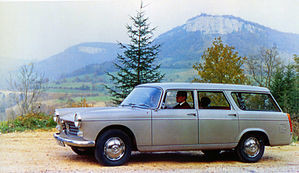
1963
A station wagon variant of the 404 was developed not long after the 404 sedan came onto the market, and in 1963 these were offered for sale. Like the 403 before it, the station wagon was purpose-built and not just a slightly longer hatchback version of the sedan. The wheelbase was extended by 190 mm (7.5 inches) to a total of 2840 mm (112 inches) and in place of the regular sedan rear suspension was a twin coil spring (2 per side) rear end with a subframe for them to sit on. The load capacity of the station wagon was 600 kg (1322 lbs.), so it was a real workhorse. A “Familiale” version of the station wagon with three rows of seating was also available, and with seating for eight, they were very useful for the typically large French families of the day. Fuel injected sedans went on the market in the 1963 model year and these 85 HP cars were rated at a 155 km/h top speed, only 3 km/h less than the Cabriolet and Coupé models. Fuel injected versions were never officially imported into the USA.
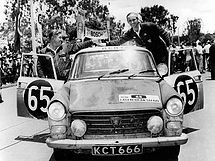
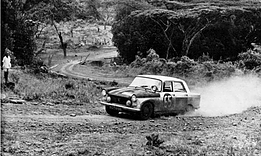
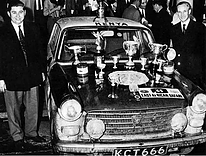
In April, Peugeot scored their first outright victory in the East African Safari Rally, with Nick Nowicki and Paddy Cliff sponsored by Marshall’s (the Kenyan Peugeot importer) taking on the field in their carbureted 404 Sedan and emerging as one of only seven finishers, on top of the leader board. Three of the seven finishers were Peugeot drivers!
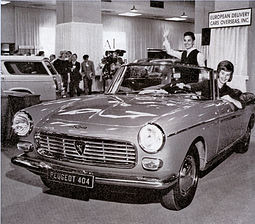
First Cabs Arriving in USA
1964
In 1964, Peugeot introduced an updated version of the XC engine with a five main bearing engine, called the XC5. The Kugelfischer injected engine was also treated to this better/stronger crankshaft and the XCKF engine became the XCKF1. Being possessed of the smoothness of 5 main bearings, the rev limit was raised, although 404 drivers never knew what the RPM was unless they had fitted their own tachometer!
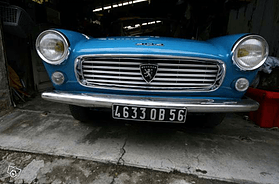
Minor changes included the abandonment of the Italian Carello round front turn indicators on the 404C models, in favour of a new ovoid design made by SEIMA in France, which had bi-coloured lenses, the orange part for turn indicators having an orange shield behind the clear cover. 404 Sedans got small rubber strips on the bumperettes (over-riders) in this model year.
The 404 Diesel with 1948 cc engine and 68 HP was introduced, although a less powerful “administrative” version of the 404 Station Wagon and sedan had been available from 1963 for taxis (1816 cc and 55 HP). Peugeot Inc. in the USA decided not to import the Cabriolet version or the fuel injected versions. However, one of Peugeot USA’s regional affiliates, called Eastern Auto Distributors, independently decided to import the 404 Cabriolet – in carbureted form only – to the USA. These cars were available on special order throughout the country. Sales in California were particularly strong. As in Europe, they were very expensive compared to the sedan.
1965
1965 was a year of even more technical developments. The carbureted XC engine got larger valves, and the power went from 72 to 76 HP. Top speed of the sedan increased from 142 to 148 km/h. The carbureted Cabriolet and Coupé saw their top speeds raised from 148 to 155 km/h (96 MPH). The fuel injected engine was upgraded again to 96 HP, in a version called the XCKF2. This power increase was achieved with a larger intake manifold, larger intake and exhaust valves (the same diameter as the valves in the latest XC5 engine). The injection system was upgraded too, with a different 3D cam being used to provide more fueling at higher RPM. Additionally, the cold start process was automated with the fitting of an auxiliary air valve attached to the injection thermostat as well as an electro-valve attached to the forward end of the intake plenum. The electro-valve sprays fuel into the intake as the starter motor is engaged. In the sedan, the KF2 engine would make for a conservative-looking 1600 cc family car that would hit and maintain 160 km/h (100 MPH). In the Coupé and Cabriolet models, the fuel injected versions had a top speed of 167 km/h (104 MPH) according to Peugeot, though road tests indicated that more than 105 MPH was possible even on a steeply banked oval circuit. The car ran out of RPM before it ran out of power and had the gearing been longer, more speed could have been on tap. But France in the sixties was just beginning its Autoroute system and chances to stretch the car’s legs were relatively rare.
The extra speed that these engine developments permitted brought with it the responsibility for a better braking system. Peugeot, being sort of contrarian and conservative in its engineering, did not make the leap to disc brakes at this time for their sedans with XC5 and KF2 engines. Rather, they remained faithful to drum brakes but reinforced them even further with a widening of the front drums and linings, plus abandonment of the Twinplex system in favour of a new Thermostable system with high heat resistant front drums, two dual acting large diameter wheel cylinders with twin leading shoes, hence no auto-servo effect that one gets with a trailing shoe. Because these were such heavy duty brakes, a servo with a lot of power was required, and Lockheed/DBA/Bendix’s Hydrovac system was chosen. With a 7:1 assistance ratio, the brake pedal was enormously sensitive to pressure, rather like a Citroën. Special brake linings with an exceptionally high resistance to heat – Ferodo 762 – were added in place of the Ferodo 4Z linings that had been used before. All of this was very effective, as road tests found that these brakes were not prone to fading after intense use, unlike previous 404 brakes.
Carbureted Sedans and Coupé/Cabriolet models were equipped for the most part with high speed Michelin XA2 (later, XAS) or Dunlop SP Sport tires, which were rated for more than the 160 km/h self-imposed limit of the Michelin X, the tire that typically had equipped these models before.
In Canada, the Injection version of the sedan became available, and the Peugeot Canada Ltée also decided to officially import both the Coupé and Cabriolet versions, and most of these had the KF2 Injection engine. Peugeot Canada also wisely decided that these more expensive versions of the 404 should come as standard with a floor gearchange, made by Nardi in Italy. Every Canadian market 404C had this piece of sporting equipment. The switch to the Nardi shifter entailed the removal of the column shifter assembly, covering the hole in the column with a black plastic cover plate, and a pair of fiberglass sound-insulated shells that were attached to the centre tunnel, to make room for the shifter unit which was directly attached to the gearbox. A new larger piece of carpet was adapted to cover all of this.
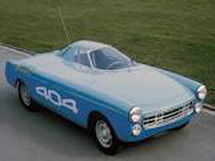
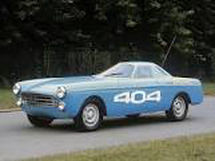
To promote the performance characteristics of their diesel engines and demonstrate that they were designed for more than just commercial vehicles, Peugeot decided to compete against Mercedes-Benz and try to break the world speed endurance record in 1965. Peugeot used a 404 convertible transformed into a one-seater monoplace with a 1948 cc diesel engine. On June 4-6 1965 on the Montlhéry Race Ring, Peugeot used 5 drivers alternating at the wheel for 72 hours to average 160 km/h (100 MPH) and set 22 international records in Class E. Then they fitted the same car with a new prototype diesel engine of 2163 cc and put the drivers back on track on July 11th, and 18 new world records were set in Class D. A total of 40 records were achieved by the iconic blue 404 diesel record car. (Watch Video Here)
In 1965, Peugeot began to assemble the 404 at the SOMA (Société de Montage Automobile) factory in St-Bruno near Montréal, alongside the Renault 8. The 404s assembled in Canada were from CKD (completely knocked down) kits. The local assembly was started to avoid punitive import tariffs. Most of the sedans assembled there – other than the Injection models – had a special badge on the rear that said “Alouette” (“Skylark” in French). Buick didn’t seem to mind!
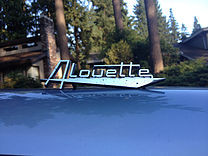
1966
For the 1966 model year, not a lot changed. An optional Automatique version of the sedan was introduced, equipped with a carbureted engine and ZF three speed conventional automatic gearbox with torque converter. The slow-selling Jaeger Coupleur versions were discontinued. Sedans got a new bumper design with fully rubber encased bumperettes (over-riders) and front turn indicators that superficially looked just like the units fitted to the 404C models since 1964 (the profile to the sides were different, however, with the Coupé/Cabriolet version having a left and right handed version because of the shape of the front panels, whereas in the Sedans and Station Wagons, both sides were symmetrical – hence, interchangeable.
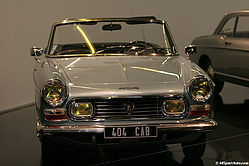
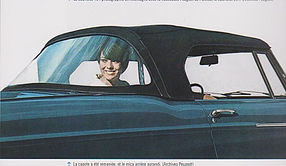
Towards the end of 1966, at the Salon d’Auto in Paris, Peugeot exhibited the 1967 version of the 404C, which had a few changes to its appearance: a new higher front bumper, a revised front face and grille panel, to allow for the fitting of two Cibié driving lights into the outboard ends of the grille. New larger front indicators were also featured, and the under-bumper air deflector panel was now welded to the shell rather than bolted to the underside of the bumper as it had been with previous models. Inside the car, the seats now had locking backrests, and the instrument panel had a new 3 dial design (still, without a tachometer).
1967 model sedans, which started production in July 1966, had some revisions too: the same instrument panel as the Coupé and Cabriolet models, and the trunk arrangement was revised to allow the spare tire to be stored under the trunk floor outside the car rather than vertically inside the trunk as had previously been the case. The external rear panel of the sedan was mildly revised too, with rectangular reflectors and a sloping part just ahead of the rear bumper. These changes were exceedingly modest and most people would not have noticed!
April 1966 was a good month for the 404: Bert Shankland and Chris Rothwell won the East African Safari Rally in their fuel injected 404 Sedan. Mr. Shankland was the service manager of Tanganyika Motors Ltd., the local Peugeot importer in Tanzania.
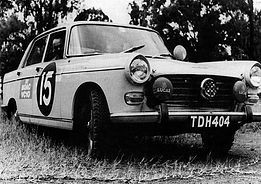
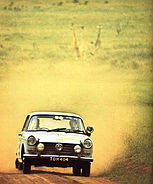
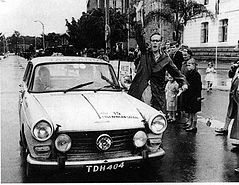
1967
For this model year, the XC5 carbureted engine became the XC6, with some minor improvements yielding an additional 4 HP, taking the total to 80. This gave the sedan a bit more performance, both in acceleration and in top speed, which was increased to 150 km/h (93 MPH) in the Sedan and 140 km/h (87 MPH) in the Station Wagon. Sedans got the new BA7 gearbox with hydraulic clutch control but in the Coupé and Cabriolet models, the C3 gearbox was still used in 1967.
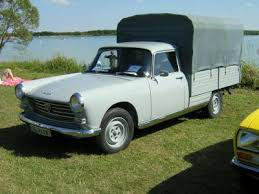
The legendary 404 Pickup was first produced in March 1967 in both carbureted and diesel form. The payload of the pickup was either 800 kg or 1000 kg, impressive for a small vehicle.
The East African Safari Rally was once again won by Shankland and Rothwell in a fuel injected 404 from Tanzania. The reputation of Peugeot in eastern Africa, already strong, was growing…this important rally-winning 404 Injection sedan is in Peugeot’s museum collection.
1968
This year was most notable for being the last year of the KF2 Injection engines, both in the sedan and the Coupé and Cabriolet models. These Pininfarina-built models were last constructed in the early fall of 1968, and the last C models had the BA7 gearbox with a new version of the Nardi floor gear shifter.
The carbureted engine continued with 80 HP and, with the advent of emission control regulations in the USA, a special version of the 404 Sedan was developed. This model had a number of changes: side marker lights, positive crankcase ventilation, a Coppolair supplementary air device, special dashboard foam padding, a 4 way flasher switch, three point front seatbelts and other special equipment. About 5000 of these versions were made in the 1968 model year for the US and Canadian markets, half of them automatic and half with the BA7 manual.
The final outright Peugeot 404 victory in the East African Safari Rally was claimed by Nick Nowicki and Paddy Cliff from Kenya in their 404 Injection sedan. The reputation of Peugeot’s 404 as the king of Africa and one of the toughest cars ever made was cemented after recording its 4th victory in six years in the world’s toughest rally, over much more powerful and exotic machinery, and to this day the 404 is lovingly referred to as “Simba” in Kenya.
1969
For 1969, another batch of US model 404 sedans was built, the last of them being early 1970 models. Over this 17-month period, 2345 manual sedans were built and 2840 automatic versions. Not all of these were sold in the USA – a significant percentage went to Canada. Canadian assembly of the Alouette sedans at the SOMA plant ended around this time.
1970
The USA and Canada got one last iteration of the 404 for 1970-71: a special version of the 404 station wagon called the U6S, equipped with a XM 1.8 litre twin carburetor engine from the first version of the 504. With 87 HP, this was the most powerful carbureted 404 ever sold. It was available in both 4 speed manual and ZF automatic guises. 746 manual versions were built, and 736 of the Automatique.
In Europe, the 404 continued in both carbureted and diesel forms, sedan, pickup and station wagon.
1971-75
The 404 sedan and station wagon remained in production through March of 1975, in carbureted and diesel form, the former with an optional automatic transmission. The pickup remained in production in France through 1979, and in some other countries – notably Kenya – through 1989!
(Watch Production History Video Montage with Original Brochures & Video Here)
Legacy
Globally, the 404 was as important to Peugeot’s reputation for toughness and high quality as was the Redex-trial winning Peugeot 203 in 1950s Australia. The towering performances the 404 delivered in endurance rallying worldwide – this article has only mentioned the East African Safari – built the legacy that the 504 continued in its own way to develop. As used cars, many 404s in Europe that were at or near the end of their service lives were shipped to Africa where they gained a second life as hard-working bush taxis and family cars. More than 2.8 million 404s were built over the decades of its production.
About Le Club 404
The 404 Club (Le Club 404) aims to support 404 owners with the provision of new old stock parts services, reproduction parts, discounts on commercial parts sources, technical support services, special tool availability, driving events and other club activities. As time allows, in North America, we will aim to provide more and more of these services, including social and driving events.
The 404 Club is engaged in a worldwide registry, attempting to find the 404s that survive today. The vast majority of 404s had tough working lives and ended up in scrapyards decades ago. But as time marches on, the remaining cars are beginning to be cherished and economically valued as collector cars, and are being restored either by their owners or professionally. At the beginning of September 2017, about 3400 sedans, station wagons and pickups have been registered at the Club by serial number, and 2119 of the Coupé and Cabriolet models are known. In the case of the 404C, this registry represents over 12.3% of the total production of 17,223 cars that were built. Not all of these are owned by Club members, though.
Because many 404s are in Africa and Latin America, we will eventually want to expand into Spanish language services at the Club, and reach out through local clubs worldwide in order to develop the Club membership and registry further.